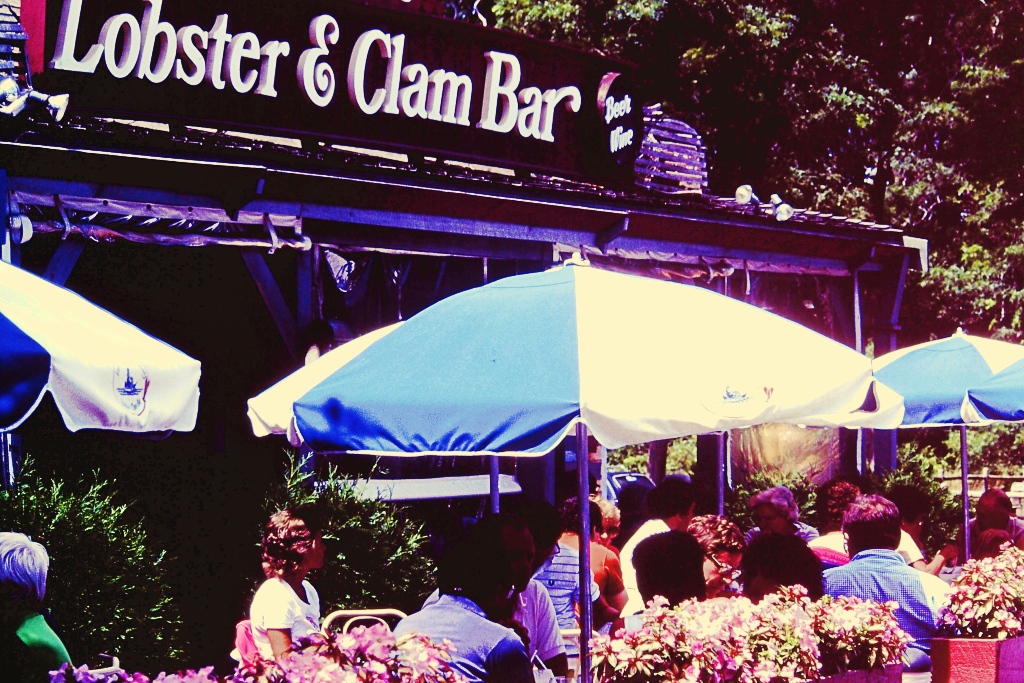New England Fish
Many kinds of fish are taken in New England's waters.
In colonial times, the codfish was so important to the region's economy that a stuffed codfish had a place of honor in the Massachusetts State House (capitol) in Boston.
Filets of choice little codfish (or any other whitefish) are called scrod. Sautéed in lemon butter or topped with a cheese sauce, they're pretty bland, as is halibut.
Bluefish, smoked and served as an appetizer or broiled for a main course, has a fuller flavor.
Monkfish sautéed in butter tastes something like lobster.
Swordfish and fresh tuna steaks are best grilled over charcoal.
Fish chowder, as made in New England, uses bland whitefish, potatoes, kernels of corn (maize), and milk.
Lobster
Shellfish are also important. Everyone knows about Maine lobster, but Massachusetts has a large lobstering fleet as well, and the state supports hatcheries where baby lobsters are raised before being released to sea.
Lobster, nearly 60 million pounds of it, is caught in summer all along the coasts of Maine, Massachusetts, New Hampshire, Rhode Island and Connecticut—in short, lobster is caught in every New England state except Vermont, which has no salt-water seacoast. Lobster is the main course of the traditional New England clambake.
Clams
Clams are of several varieties. Soft-shell clams have shells that chip and crack more easily than those of regula, hard-shell clams. Soft-shell clams are usually steamed in the shells, which gave rise to their other name, steamers. More...
Hard-shell clams have hard porcelain-like shells. Among the most popular species are littlenecks and cherrystones. Hard-shell clams may be steamed, baked, or served raw on the half shell with lemon, tomato sauce, or a dab of horseradish.
Quahogs (pronounced KO-hogz) are clams larger than your fist. They're often cut into strips, fried in batter, and served as fried clams at roadside or beachfront snack stands, or minced for use in clam chowder. Huge sea clams are also cut into strips to make fried clams.
New England clam chowder has clams and potatoes in a base of milk or cream. It's quite different from Manhattan clam chowder, which uses tomato instead of milk, and is an abomination to New Englanders.
Oysters
Oysters from Chatham, Wellfleet, and Cotuit on Cape Cod are usually eaten raw on the half shell, or served whole in milk-based oyster stew.
Traditional New England Dishes
Many traditional New England foods are not often served anymore. Boston was once famous for baked beans (navy beans, molasses, salt pork, and onions cooked slowly in a crock), but very few restaurants serve them nowadays, and then mostly for sentimental or touristic reasons. New England boiled dinner, a chunk of beef boiled with cabbage, carrots and potatoes, is also rarely served—perhaps just as well.
Wine & Cheese
All six of the New England states also have their own vineyards and wineries providing just the right beverage to go with the cheese.
Vermont is dairy country, known for its 46 artisanal cheesemakers.
Maple Syrup
All of the New England states produce delicious maple syrup from the sap of the sugar maple tree in the late winter and early spring. Many inns and some restaurants serve it with breakfast pancakes and waffles, and creative restaurant chefs use it in many recipes. More...
Fruits & Desserts
As for dessert, fresh fruit and fruit pies are the best. Strawberry season is early- to mid-June. Rhubarb is also ripe then, and if you come across a strawberry-rhubarb pie, don't let it get away whole.
Late June to mid-July is blueberry season, when pies of fresh blueberries appear.
Autumn brings peaches, plums and apples, and also gallons of fresh-squeezed apple cider. Look for it at roadside stands throughout the region. More...
New England Drinks
New Englanders make their own wine from grapes and, traditionally, from other fruits as well. And there's always apple cider. More...

